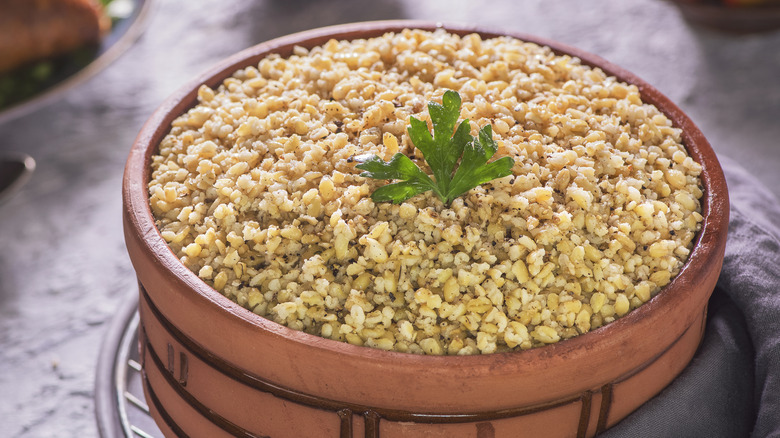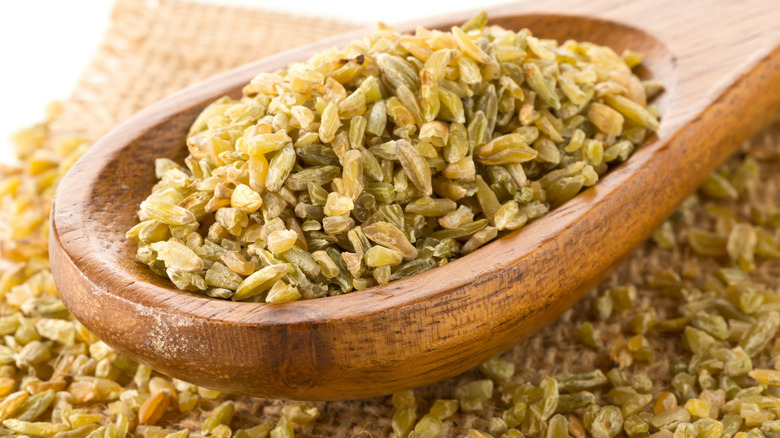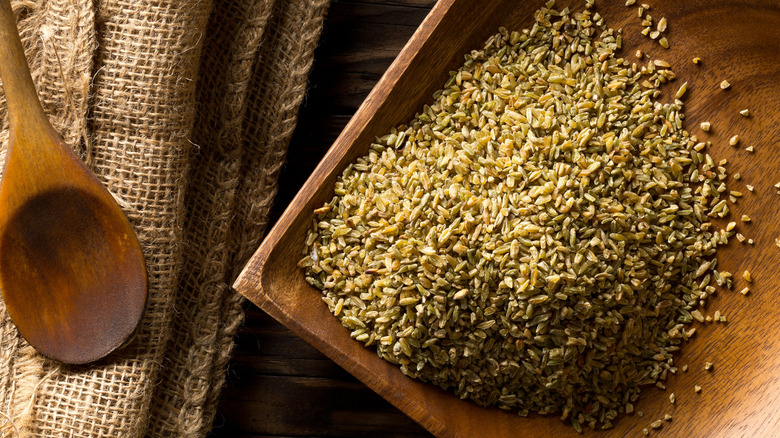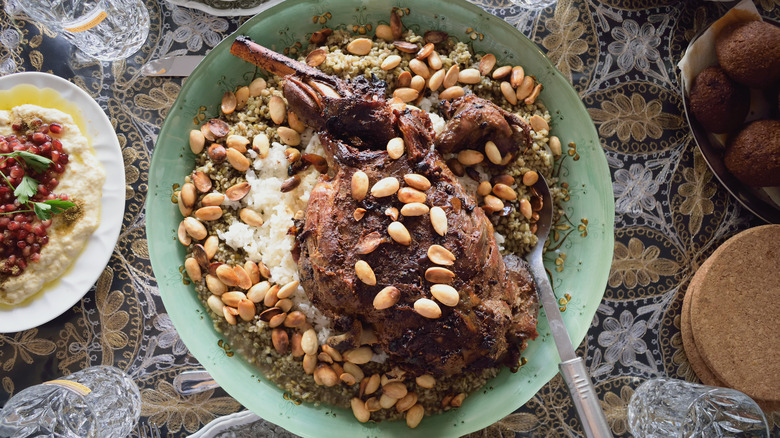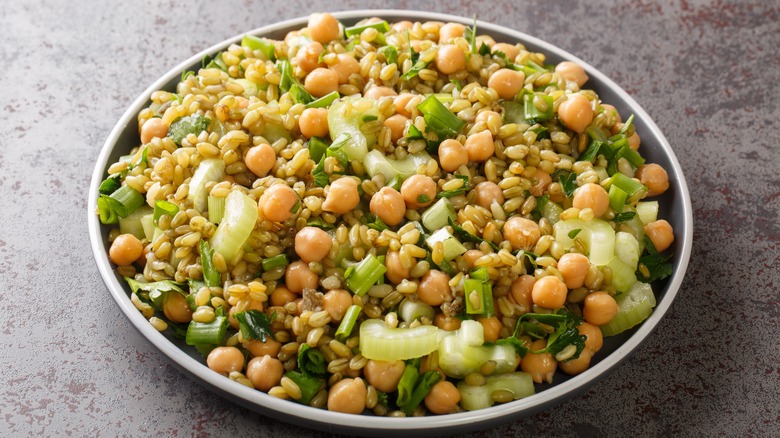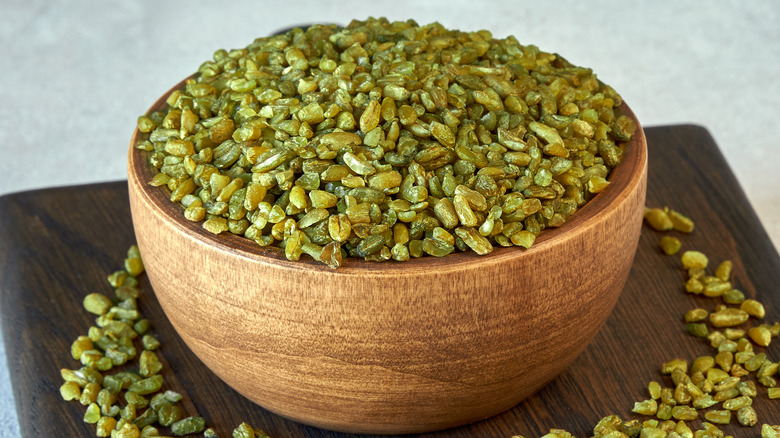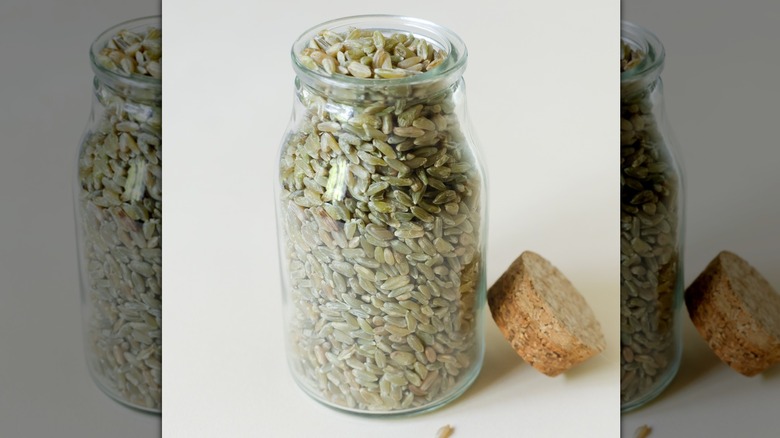Freekeh Is The Ancient Ingredient You Should Be Using More Often
The hype around superfoods and super grains has died down a little over the past few years, but eating healthily while eating well is still a huge priority for all of us. If you're on the lookout for delicious and nutritious additions to your kitchen, then don't sleep on freekeh. Despite a solid attempt to market freekeh as the quinoa killer, this super grain has remained a little-known import from the Middle East. But just because everyone else is in the dark doesn't mean you need to be.
Similar to bulgur wheat, freekeh is great hot or cold and boasts a high fiber and protein content. Although there is no shortage of freekeh-specific recipes out there, because it's a whole grain, you can substitute it into any grain recipe you like. It makes for a great alternative to both rice and oats, so the sky's the limit on what you can make.
What is freekeh?
Freekeh (pronounced free-kah) is harvested from durum wheat while the plant is still green – before reaching maturity. Its name derives from the Arabic word meaning 'to rub' due to how the grain is processed; you may also sometimes see it referred to as farik or frik. The wheat is placed over an open flame, which burns away the unwanted chaff. The wheat is then rubbed or thrashed to remove all the burnt bits, leaving only the freekeh behind.
Legend has it this method was discovered around 2,300 B.C. in the middle of a war. A village in the Eastern Mediterranean was worried about an approaching army, so they harvested their wheat early and stored it in their barns. As the army swept through, the barns were burned down. When the villagers returned, they discovered that they could still use the grain when they rubbed away the burnt pieces. Today, freekeh is commonly used in the Middle East and North Africa. Because it's harvested young, farmers don't need to spend as much time or water producing it, making it attractive from an economic point of view.
Cracked vs. whole freekeh
Like many other whole grains, freekeh can be bought cracked or whole. Cracked freekeh is whole freekeh that has been broken up into smaller pieces. The primary benefit of cracked freekeh is that it cooks faster since there's more surface area. If you've ever had bulgur before, cracked freekeh has a similar texture. Each brand is going to crush the freekeh to different sizes, so if you like a certain size, shop around until you find the style of cracked freekeh you like best.
Whole freekeh has not been broken up. It's freekeh that is, well, whole. The germ, bran, and endosperm are all intact, which is why whole freekeh takes longer to cook. Unlike other grains, whole freekeh isn't any more nutritious than the cracked version because cracked freekeh doesn't process these parts away. You're still getting the whole grain (the bran, germ, and endosperm). It's just been broken up, so the nutritional difference isn't as noticeable as it is with some other grains. For example, white rice has removed the bran and germ completely, which is why brown rice is more nutritious.
What does freekeh taste like?
Because it's produced over an open flame, freekeh has a characteristically smoky flavor to it combined with a lovely nuttiness. The nuttiness is similar to what you'll find in other whole grains, such as bulgur, but it's the smokiness that really sets it apart. There are also flavored versions, like rosemary-sage freekeh. Texturally, whole freekeh is somewhat chewy. Cracked freekeh is going to lose a little bit of the chewiness, though it depends on how finely ground the grain is.
The smokiness goes very well with salt and citrus, so if you're looking for ingredients to pair it with, keep that in mind. Adding a little lemon juice on top of your dish is going to make the flavors pop, and adding salty cheeses like feta or provolone will round out the dish. Although freekeh does have a smoky flavor, it's subtle and won't overpower your other ingredients, so feel free to add it to any other whole-grain recipe you have.
How to cook with freekeh
Freekeh cooks similarly to other grains, typically by boiling it in water or broth. Whole freekeh takes around 40 minutes to cook, while cracked freekeh only takes 20 minutes. The ratio of grain to water is, for every 1 cup of freekeh, you'll need 2 ½ cups of water (though you should check the manufacturer's instructions beforehand), which will yield 3 cups of cooked freekeh. If you're cooking freekeh as a side dish, you'll use this method to cook it as you would rice. Certain recipes, such as soups, will incorporate cooking the freekeh into the recipe as a whole, while others will require cooked freekeh to begin with. If you want to spice things up, adding cinnamon or saffron to the pot before boiling can take your freekeh's flavor to the next level.
Freekeh makes a good substitute for rice or oats, so feel free to add it as a base to a curry or top it off with yogurt for a new breakfast staple. Freekeh is good enough on its own, but adding cooked freekeh to salads can give them substance and a boost texturally while also contributing that delicious smoky flavor. It's highly versatile, so get creative with it. Freekeh can also be milled down into flour for making bread or other baked goods.
Where to buy freekeh
Freekeh is becoming more popular, so many grocery stores will carry at least one brand. If your local grocery store doesn't have it, try one that's focused on healthier options or organic products, such as health food stores or co-ops. More often than not, you'll find it with the other grains, but make sure to look in the international aisle in the Middle Eastern section if you're having trouble. You can also look for Middle Eastern or African grocery stores near you since they will likely carry brands that may be more commonly used in those regions.
If you can't find it at a local grocery store or don't want to go through the trouble of tracking it down, you can always buy freekeh online. Amazon will, of course, carry it, but if you are looking for a specific brand, you can often order it from their website. Some brands will also have store locators, which tell you where their product is being sold.
Nutritional information about freekeh
The first thing to note about freekeh is that it is not gluten-free since it's a particular type of wheat. For those of you who are able to digest gluten, freekeh is a fantastic source of nutrients. Some foods that are harvested early have a bad reputation for not being as nutritious, but freekeh doesn't have that problem.
In ¼ cup of uncooked freekeh (which will expand to about ¾ cup of cooked freekeh), you can expect a full 4 ½ grams of fiber -– roughly three times as much as brown rice. That's not to mention the 5 grams of protein, which is good even compared to other protein-rich whole grains. Then there are the micronutrients like manganese, phosphorous, and magnesium. The same serving size offers 52% of your daily value of manganese, an important nutrient for bone health. And 16% of your daily value of phosphorus is included, something you'll need for healthy teeth and bones. Magnesium is good for blood sugar and blood pressure, and you'll get 13% of your daily value with freekeh.
How to store freekeh
Freekeh should be stored similarly to other whole grains, though cracked and whole freekeh should be stored differently. Because its protective casing is intact, whole freekeh will stay fresh for much longer. Keep it in an airtight container in your pantry, away from sun and moisture, and it'll keep for several years. Cracked freekeh, on the other hand, will only last a few months. If you want to store your cracked freekeh for longer than that, go ahead and store it in your fridge or freezer in an airtight container.
Cooked freekeh will spoil as quickly as most other cooked foods. You can keep cooked freekeh in your fridge for up to three days before it's likely gone bad. Freekeh can also be frozen for up to three months, which is a nice option if you're making a big batch. Just remember to keep your cooked freekeh in an airtight container for freshness.
